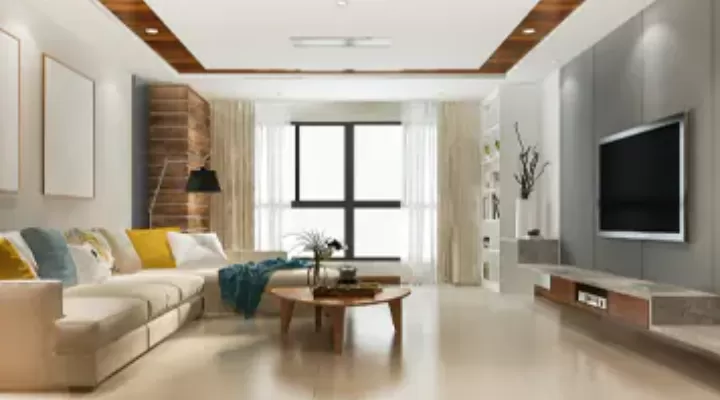As the new year dawns, many of us embark on home renovation projects to breathe fresh life into our living spaces. When planning these renovations, we often overlook the "fifth wall" of our rooms—the ceiling. However, paying attention to the ceiling during room design can set your space apart and infuse it with a unique charm. One effective way to introduce an exquisite design element to your room is by incorporating a false ceiling. A false ceiling is a secondary ceiling suspended below the original ceiling, allowing for creative design possibilities. Whether you prefer a vintage or modern aesthetic, a false ceiling can serve as the perfect canvas for decorative lighting fixtures and can discreetly conceal unattractive AC vents. It adds a touch of sophistication that elevates the room's overall appearance. From elegant lattice designs in the living room to whimsical details in children's rooms, false ceilings can be adapted to suit any space. Moreover, they are commonly used in office buildings to hide wires and pipes, enhancing the aesthetics of the workspace.
In the past, false ceilings were constructed from flimsy materials like cardboard and cork, which lacked durability. However, modern advancements have introduced superior alternatives, with gypsum emerging as a top choice.
Introducing Gypsum
Gypsum is a white, chalk-like material that is mined from sedimentary rock deposits. Chemically, it is known as Calcium sulfate dihydrate (CaSO4:2H2O). For centuries, gypsum has been employed globally for sculptures and wall plastering. It boasts compressive strength comparable to cement while being significantly lighter. Despite its historical use in sculptures, gypsum is now being rediscovered as a construction material, especially for drywalls and false ceilings. Innovative techniques have been developed to create high-quality building materials from gypsum.
Why Gypsum is the Ultimate Material for False Ceilings
-
Resistant to Cracking: Unlike cement, which is prone to shrinkage and cracking, gypsum does not require curing to prevent cracks. It offers both compressive and tensile strength, making it highly resistant to cracking. Gypsum boards are soft and flexible, reducing the likelihood of cracks. Additionally, gypsum does not warp in moist conditions, providing resistance against damage from seepage.
-
Superior Thermal Insulation: Gypsum provides excellent thermal insulation, contributing to energy efficiency. It helps maintain cooler temperatures in the room during hot weather, enhancing the effectiveness of air conditioning. Conversely, in colder environments, it traps heat, resulting in energy savings. The air layer between the false ceiling and the actual ceiling further enhances insulation, reducing the need for excessive cooling or heating.
-
Fire Resistance: Unlike traditional materials like wood and cork used for false ceilings, gypsum acts as a fire barrier. It contains water in its crystal structure, inhibiting fire. When exposed to flames, gypsum releases water as steam, thwarting the fire's progress. Many gypsum boards are treated for additional fire resistance, making them ideal for safety-conscious applications.
-
Rust Inhibitor: Gypsum prevents the rusting of metal supports embedded within it. Electrical fittings and pipes installed in gypsum plaster remain corrosion-free. Its low moisture absorption, around 5%, ensures that metals do not corrode.
-
Lightweight, Sturdy, and Flexible: Gypsum is significantly lighter than cement plaster and plaster of Paris (POP). A thin layer of gypsum plaster (less than 6mm) provides the same strength as a thicker cement layer (over 10mm), reducing maintenance requirements. Gypsum boards are flexible and easily moldable into various designs. They reflect light evenly, creating a well-lit ambiance. Their smooth finish eliminates the need for additional polishing, and well-constructed gypsum false ceilings can last for over two decades.
-
Environmentally Friendly: Gypsum boards require less energy for manufacturing compared to cement plaster. The manufacturing process also emits less CO2 per unit weight. Additionally, gypsum boards are fully recyclable, reducing environmental impact. Gypsum is abundant in nature, and its mining process is less damaging compared to other minerals. Thus, gypsum has a smaller ecological footprint than alternative materials.
-
Versatility and Design Variety: Gypsum false ceilings are available in a wide range of designs to suit your home's aesthetics. They are cost-effective and easy to install, often requiring simple adhesive application instead of nails. Maintenance is rarely needed, and repairs, if necessary, are straightforward. Gypsum boards are compatible with various paint finishes and come in various colors. They can conceal unsightly wires and support recessed light fixtures.
In conclusion, gypsum is the ultimate choice for false ceiling design due to its numerous advantages. It offers resistance to cracking, superior insulation, fire resistance, rust inhibition, lightweight flexibility, eco-friendliness, and a wide range of design options. When considering false ceilings for your home or office, gypsum emerges as the perfect material to enhance aesthetics and functionality. Embrace gypsum, and elevate your space to new heights of elegance and sophistication.


